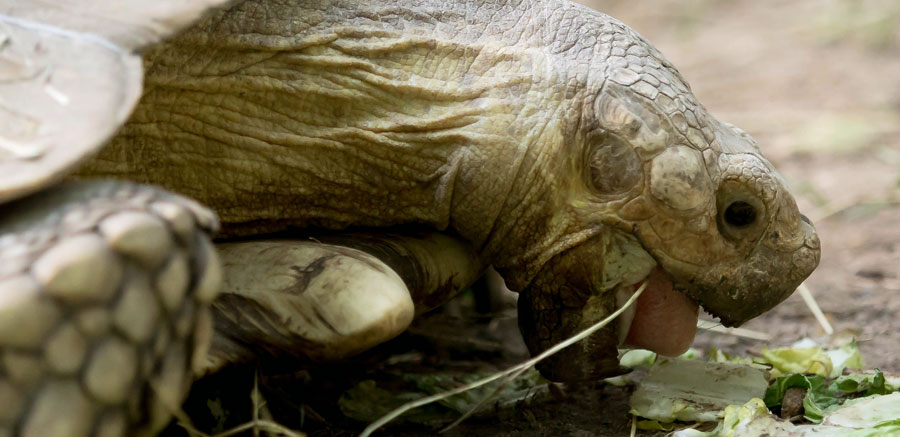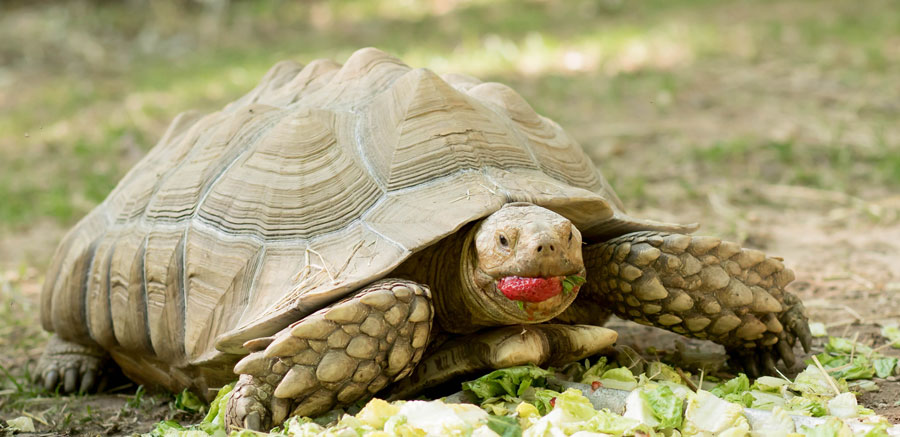
SULCATA TORTOISE
The third largest tortoise after Galapagos and Aldabra, Sulcatas can grow as large as 30 inches and weigh over one hundred pounds.
PROFILE
Roos and Ruby came to us from a private donator. Roos is the larger male, weighing in around 80-90 pounds. Ruby is our smaller female. Roos is more likely to approach the keepers during feeding time, while Ruby is pretty shy.
OVERVIEW
CONSERVATION STATUS
Vulnerable
AVERAGE SIZE
Compared to a 6′ Man
AVERAGE WEIGHT
90 – 200 lbs
AVERAGE LIFESPAN
80+ Years
DIET
Herbivore
REGIONS
Africa
Tortoises and turtles have roamed the Earth for over 200 million years. Sulcata Tortoises are native to the Sahara Desert, the semiarid grasslands, savannas, and shrublands of the Sahel in Africa. To keep cool in such a hot climate, they will burrow in dens that are up to 10 feet deep. They are bred and sold in the U.S. as pets, as they are very cute when they are young and tiny. Due to their large size as adults and long lifespan, owners often find they can no longer manage or keep them.
APPEARANCE
Infant sulcatas are a mere 2 inches long but will nearly double in size throughout their first few years of life. Males will grow to weigh upwards of 200 pounds and 30 inches in length. Female adults will average 90 pounds and 20 inches in length.
Their shells are attached to their spine and their rib cage. The carapace, or top of the shell, is made up of 59 to 61 bones covered by “scutes,” which are plates made of keratin (like our fingernails.) The plastron is the underside or bottom. Tortoises can feel pressure and pain through their shells.
They are also referred to as African Spurred Tortoises because they have “spurs” on their front legs. They have long claws which they use to dig burrows and nests. Turtles and tortoises do not have teeth, so they break up their food with their sharp beak and then salivate in order to swallow. It is very important that they have a proper diet to avoid abnormal bone development and overgrown beaks. Although very small, they do have ears, but only hear low frequency sounds. They have an excellent sense of smell along with a sensitive patch near their mouth called a “Jacobsen’s Organ” that further aids their ability to locate food and the opposite sex.
CHARACTERISTICS
Sulcata tortoises are very intelligent, curious animals. Their diet consists of plants and grasses, along with a variety of weeds, flowers, and cacti. They will eat fruits and vegetables but should only have them sparingly. They can go weeks without food or water and are capable of consuming 15% of their body weight when available. Sulcatas do not hibernate but benefit from burrows or enclosures to protect them from heat and colder temperatures.
Mating occurs during the warmer months. Males tend to be aggressive, with each other as well as with females, eventually forcing them into submission. Sulcatas are unique in that many eggs may be fertilized during one mating, but they are “shelled” and laid in numerous clutches up to four years later. Females will dig a few nests, choosing the best one to lay two to twelve eggs. She carefully moves each out of the way, covering it in soil, before the next is laid to avoid breaking the shell. Once that clutch is laid, all of the eggs are covered in soil, allowing them to stay warm and incubate for about eight months.




